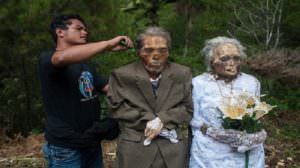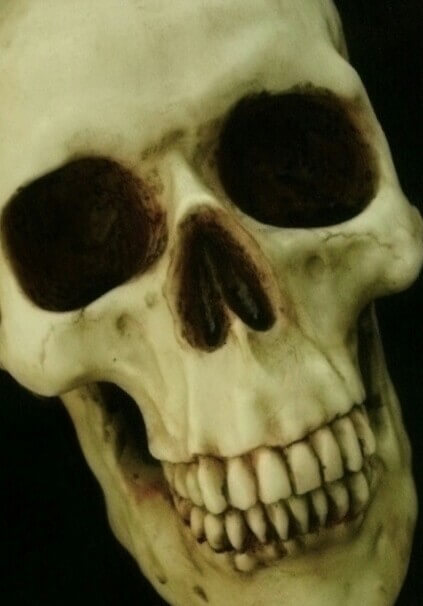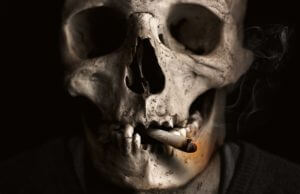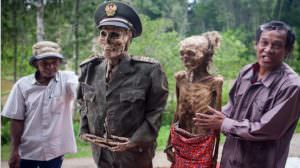Acknowledging the dead is a common practice for many societies: From Mexico’s Día de los Muertos to America’s Memorial Day, remembering and honoring our lost loved ones allows us to consciously recognize their absence. However, some cultures take remembering and honoring their dead to another, much higher, level. For example, some of the residents in Toraja, Indonesia, practice a ritual that is referred to as Ma’nene (The Ceremony of Cleaning Corpses). This ritual is performed on the dead every three years. These Torajans believe that the Ma’nene Ritual strengthens their bonds with their deceased relatives.
The Ma’nene Ritual in Indonesia’s Providence of South Sulawesi
The majority of the 650,000-people residing in Toraja are Muslim or Christian; however, there is a small fraction of Torajans who still follow ‘Aluk Todolo’ (Way of the Ancestors). Families residing in Toraja, who follow the Way of the Ancestors, exhume their deceased loved ones every three years to groom them and then dress them in posh new clothes. Part of the corpse cleaning process involves using a dry paintbrush to brush away any loose particles before redressing the corpse in his or her posh new attire.
For those who practice the Ma’nene Ritual, this exhuming and grooming ceremony is performed for all their deceased loved ones, including babies, and children. In addition to primping the deceased, each gravesite/tomb is tidied and damaged coffins are either repaired or completely replaced.
The Ma’nene Ritual Parade

A grandson is combing the hair of his deceased grandparents in the middle of the Ma’nene ritual (screenshot from DailyMail.com).
Once the coffin repairs have been made, the gravesites are tidy and the loved ones are dressed, the mummified corpses are walked around the province for all to see. This walk resembles a parade as family members follow pathways of straight lines. According to the Toraja, these pathways connect them with a spiritual entity that has supernatural power (Hyang). Experts at Ancient Origins state that this straight path is necessary because Hyang’s supernatural power only moves in straight lines. According to the Torajan people, the Ma’nene festival is a celebration of life, not of death.
The Purpose of The Ceremony of Cleaning Corpses
This ceremony began hundreds of years ago when Pong Rumasek was hunting in the mountains and came upon an abandoned corpse beneath a tree: Prior to performing a proper burial, Rumasek decided to use his own clothes to dress the corpse. Rumasek thinks that this action brought him good luck. This belief that the spirits will reward them for taking care of their corpses has encouraged the continuation of this tradition.
The Initial Burial Ritual of the Torajans
While the Ma’nene Ritual is performed on the corpses of deceased family members every three years, the initial burial of a loved one is also an extremely important and elaborate event. Funeral rituals are very expensive; therefore, it is common for a Torajan to save money throughout his or her lifetime to pay for their burial ceremony. Furthermore, in the event that adequate funds are not available at the time of an individual’s death, the funeral may be postponed for several years: This allows family members time to save enough money to give their loved one an extravagant farewell celebration as they are sent off to the afterlife. Relatives believe that an elaborate send-off strengthens the connection between the living and the departed.
The Funeral Ritual Lasts for Several Days
The slaughter of buffalos and pigs marks the beginning of the burial ceremony. This slaughter is performed to ensure the departed family member enjoys a peaceful afterlife. The horns of the slaughtered buffalo are placed outside the home of the departed Torajan’s relatives: The number of horns placed outside the home indicates the status of the deceased (more horns indicate a higher status).
In years past, the body of the departed was placed in a cave resting at the top of a cliff; however, due to the fact that bodies were being stolen, families began to keep their loved ones in their homes until burial. These deceased individuals are referred to as ‘the one who is asleep’ or ‘a person who is sick.’ These terms are used because locals think that an individual is not truly dead until he or she is actually buried.
The Importance of Burial Location
Burial location is another very important factor for the Torajans: According to tradition, blood relatives are supposed to be buried together. For this reason, it is considered a breach of loyalty to family if a husband and/or wife voice a desire to be buried together. A request such as this indicates that the individual places the love for his or her spouse above the bonds of blood relatives. Additionally, it is customary for a Torajan to be buried in the area where he or she expired or spent most of his or her life. Any deviation from these traditions can cause great tension among families.
When a young tribe member dies, he or she is placed in the smallest burial grounds. This burial ground is referred to as the ‘Baby Trees.’ In the event that a child expires before he or she has started teething, the body is wrapped in a cloth and put inside a previously prepared hollowed space in the trunk of a tree. It is believed that as the tree heals, the child’s soul will bond with it.
Final Thoughts
For those of us who reside outside of the Toraja region, many of these practices seem bizarre; however, when you think about it, our initial burial practices are not much different than theirs. We generally have a Wake lasting several days and instead of bones, people bring plants, and flowers. Then, we have a burial ceremony at the cemetery. Following the ceremony, we typically share a meal provided by the immediate family of the deceased. While the Torajans’ initial burial ceremonies have many similarities to our burial practices, their tradition of exhuming, grooming and dressing the corpse of a loved one every three years is much more difficult to understand.
Sources:
http://www.mirror.co.uk/news/weird-news/villagers-dig-up-bodies-dead-8796335
http://www.cracked.com/article_21343_the-5-creepiest-death-rituals-from-around-world-part-2.html
http://www.nydailynews.com/news/mummies-new-wardrobe-part-ma-nene-ritual-indonesia-gallery-1.1143923
http://www.nationalgeographic.com/magazine/2016/04/death-dying-grief-funeral-ceremony-corpse
https://www.nationalgeographic.org/media/dia-de-los-muertos
Interesting Video




